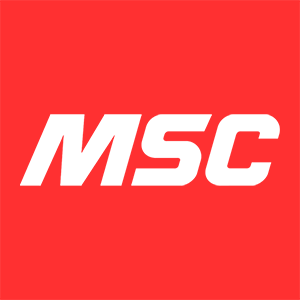
Rush Enterprises (RUSHA)
Rush Enterprises is up against the odds. Its weak sales growth and declining returns on capital show its demand and profits are shrinking.― StockStory Analyst Team
1. News
2. Summary
Why We Think Rush Enterprises Will Underperform
Headquartered in Texas, Rush Enterprises (NASDAQ:RUSH.A) provides truck-related services and solutions, including sales, leasing, parts, and maintenance for commercial vehicles.
- Flat sales over the last two years suggest it must find different ways to grow during this cycle
- Sales over the last two years were less profitable as its earnings per share fell by 12% annually while its revenue was flat
- Estimated sales decline of 3.6% for the next 12 months implies an even more challenging demand environment


Rush Enterprises falls short of our expectations. You should search for better opportunities.
Why There Are Better Opportunities Than Rush Enterprises
High Quality
Investable
Underperform
Why There Are Better Opportunities Than Rush Enterprises
At $54.63 per share, Rush Enterprises trades at 16.8x forward P/E. This multiple is cheaper than most industrials peers, but we think this is justified.
Cheap stocks can look like great bargains at first glance, but you often get what you pay for. These mediocre businesses often have less earnings power, meaning there is more reliance on a re-rating to generate good returns - an unlikely scenario for low-quality companies.
3. Rush Enterprises (RUSHA) Research Report: Q3 CY2025 Update
Commercial vehicle retailer Rush Enterprises (NASDAQ:RUSH.A) announced better-than-expected revenue in Q3 CY2025, but sales were flat year on year at $1.88 billion. Its GAAP profit of $0.83 per share was 1.8% above analysts’ consensus estimates.
Rush Enterprises (RUSHA) Q3 CY2025 Highlights:
- Revenue: $1.88 billion vs analyst estimates of $1.78 billion (flat year on year, 5.7% beat)
- EPS (GAAP): $0.83 vs analyst estimates of $0.82 (1.8% beat)
- Operating Margin: 5.3%, down from 6.3% in the same quarter last year
- Market Capitalization: $3.95 billion
Company Overview
Headquartered in Texas, Rush Enterprises (NASDAQ:RUSH.A) provides truck-related services and solutions, including sales, leasing, parts, and maintenance for commercial vehicles.
Rush Enterprises was founded in 1965 to address the growing demand for commercial truck sales and services. The company started as a single dealership and has since expanded to become a significant player in the commercial vehicle industry.
Rush Enterprises provides an array of services, including the sale and leasing of new and used commercial vehicles, parts distribution, and maintenance services. The company supports various industries by ensuring that businesses have access to well-maintained commercial vehicles. For example, Rush Enterprises helps transportation companies keep their fleets operational by providing timely maintenance and readily available replacement parts.
The primary revenue sources for Rush Enterprises come from vehicle sales, leasing agreements, parts sales, and maintenance services. The company's business model focuses on building long-term relationships with customers through a network of dealerships and service centers. Rush Enterprises appeals to businesses seeking comprehensive truck-related solutions, generating recurring revenue through service contracts and ongoing parts sales.
4. Vehicle Parts Distributors
Supply chain and inventory management are themes that grew in focus after COVID wreaked havoc on the global movement of raw materials and components. Transportation parts distributors that boast reliable selection in sometimes specialized areas combined and quickly deliver products to customers can benefit from this theme. Additionally, distributors who earn meaningful revenue streams from aftermarket products can enjoy more steady top-line trends and higher margins. But like the broader industrials sector, transportation parts distributors are also at the whim of economic cycles that impact capital spending, transportation volumes, and demand for discretionary parts and components.
Competitors in the commercial vehicle industry include PACCAR (NASDAQ:PCAR), Penske (NYSE:PAG), and Covenant (NASDAQ:CVLG).
5. Revenue Growth
A company’s long-term sales performance can indicate its overall quality. Any business can put up a good quarter or two, but many enduring ones grow for years. Thankfully, Rush Enterprises’s 9.9% annualized revenue growth over the last five years was solid. Its growth beat the average industrials company and shows its offerings resonate with customers.
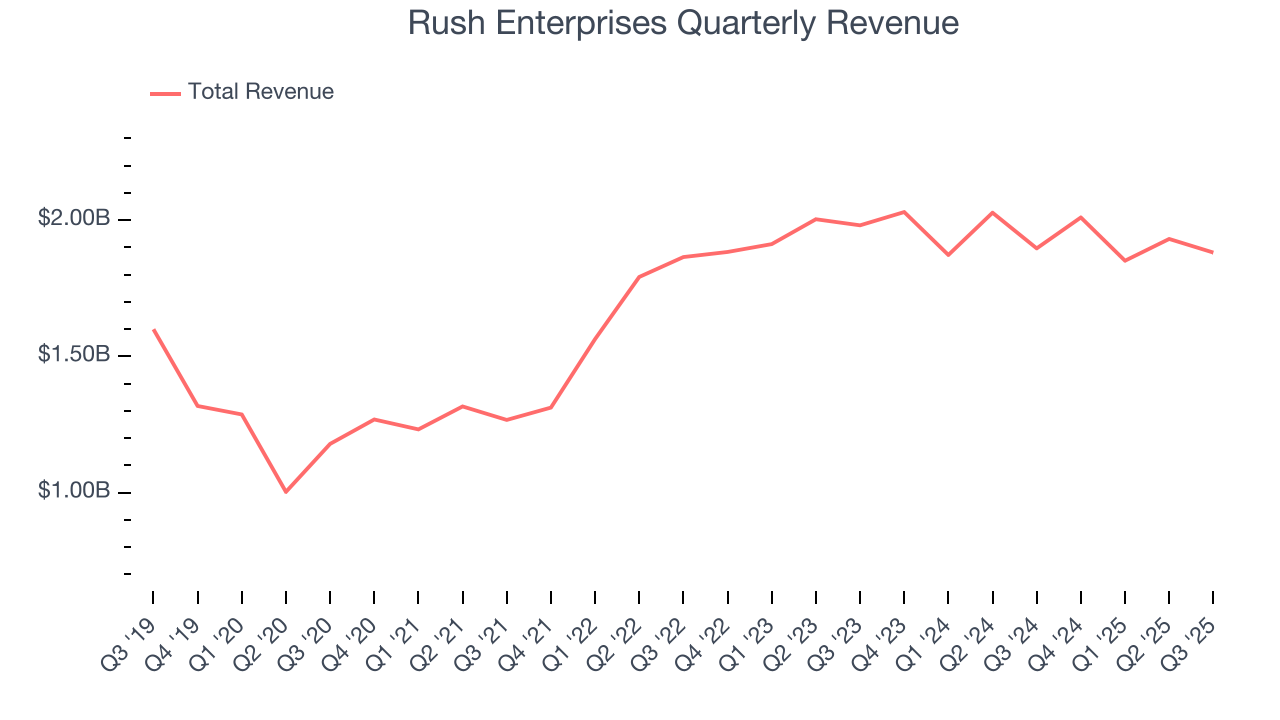
Long-term growth is the most important, but within industrials, a half-decade historical view may miss new industry trends or demand cycles. Rush Enterprises’s recent performance shows its demand has slowed as its revenue was flat over the last two years. 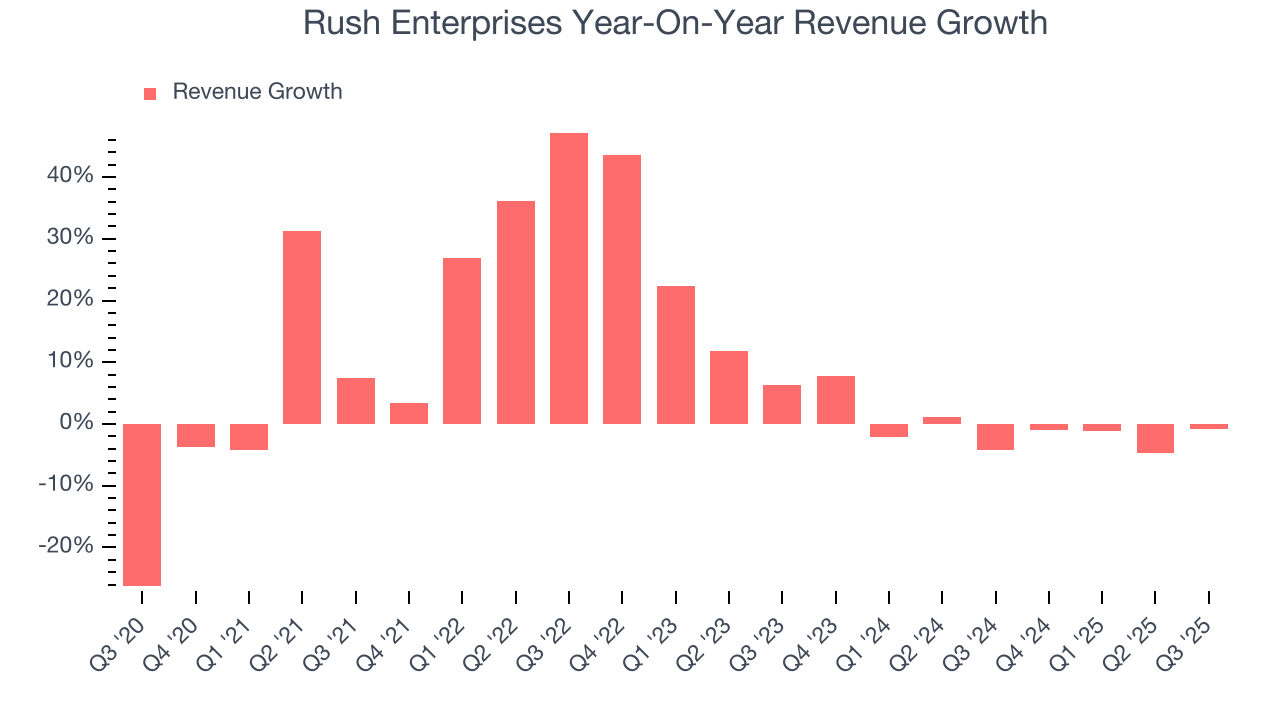
We can dig further into the company’s revenue dynamics by analyzing its most important segments, Vehicles and Aftermarket, which are 31.5% and 20.9% of revenue. Over the last two years, Rush Enterprises’s Vehicles revenue (new and used commercial trucks) averaged 18.9% year-on-year declines while its Aftermarket revenue (parts and services) averaged 13.7% declines. 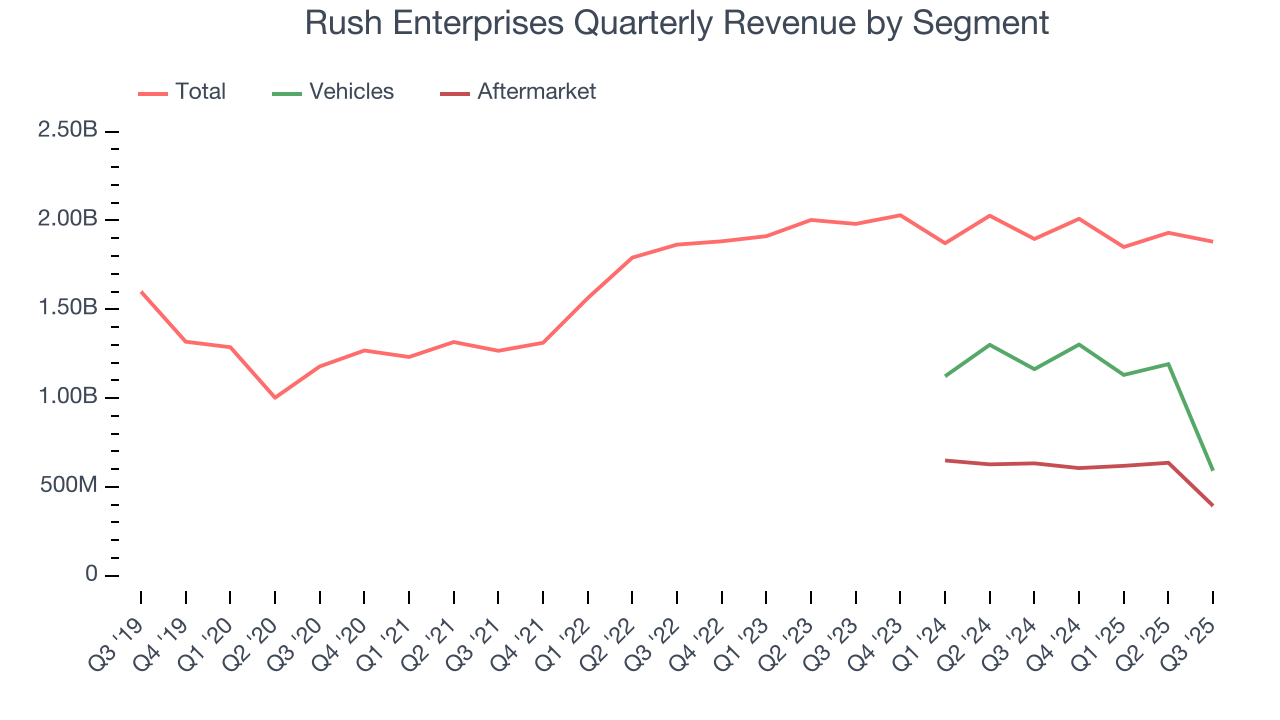
This quarter, Rush Enterprises’s $1.88 billion of revenue was flat year on year but beat Wall Street’s estimates by 5.7%.
Looking ahead, sell-side analysts expect revenue to decline by 3.5% over the next 12 months, a slight deceleration versus the last two years. This projection doesn't excite us and suggests its products and services will see some demand headwinds.
6. Gross Margin & Pricing Power
Rush Enterprises has bad unit economics for an industrials business, signaling it operates in a competitive market. As you can see below, it averaged a 20.3% gross margin over the last five years. That means Rush Enterprises paid its suppliers a lot of money ($79.70 for every $100 in revenue) to run its business. 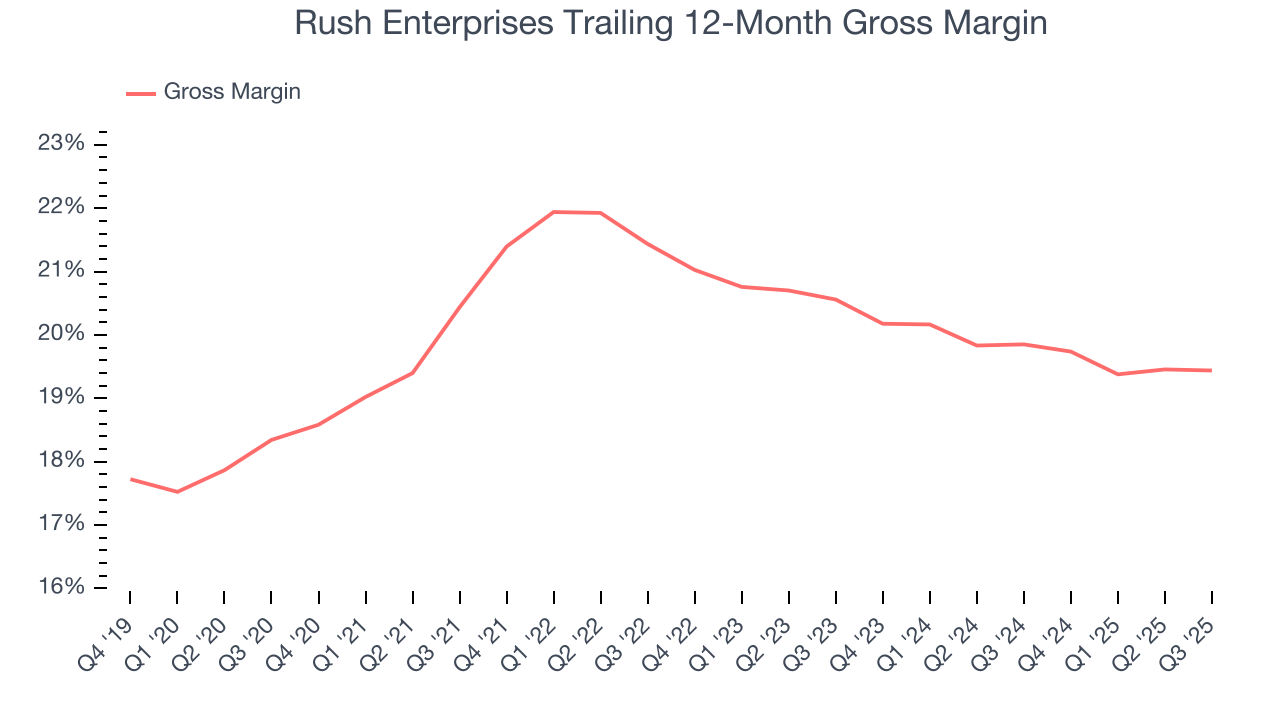
Rush Enterprises’s gross profit margin came in at 19.9% this quarter, in line with the same quarter last year. Zooming out, the company’s full-year margin has remained steady over the past 12 months, suggesting its input costs (such as raw materials and manufacturing expenses) have been stable and it isn’t under pressure to lower prices.
7. Operating Margin
Operating margin is a key measure of profitability. Think of it as net income - the bottom line - excluding the impact of taxes and interest on debt, which are less connected to business fundamentals.
Rush Enterprises’s operating margin might fluctuated slightly over the last 12 months but has remained more or less the same, averaging 6.1% over the last five years. This profitability was paltry for an industrials business and caused by its suboptimal cost structureand low gross margin.
Looking at the trend in its profitability, Rush Enterprises’s operating margin might fluctuated slightly but has generally stayed the same over the last five years. This raises questions about the company’s expense base because its revenue growth should have given it leverage on its fixed costs, resulting in better economies of scale and profitability.
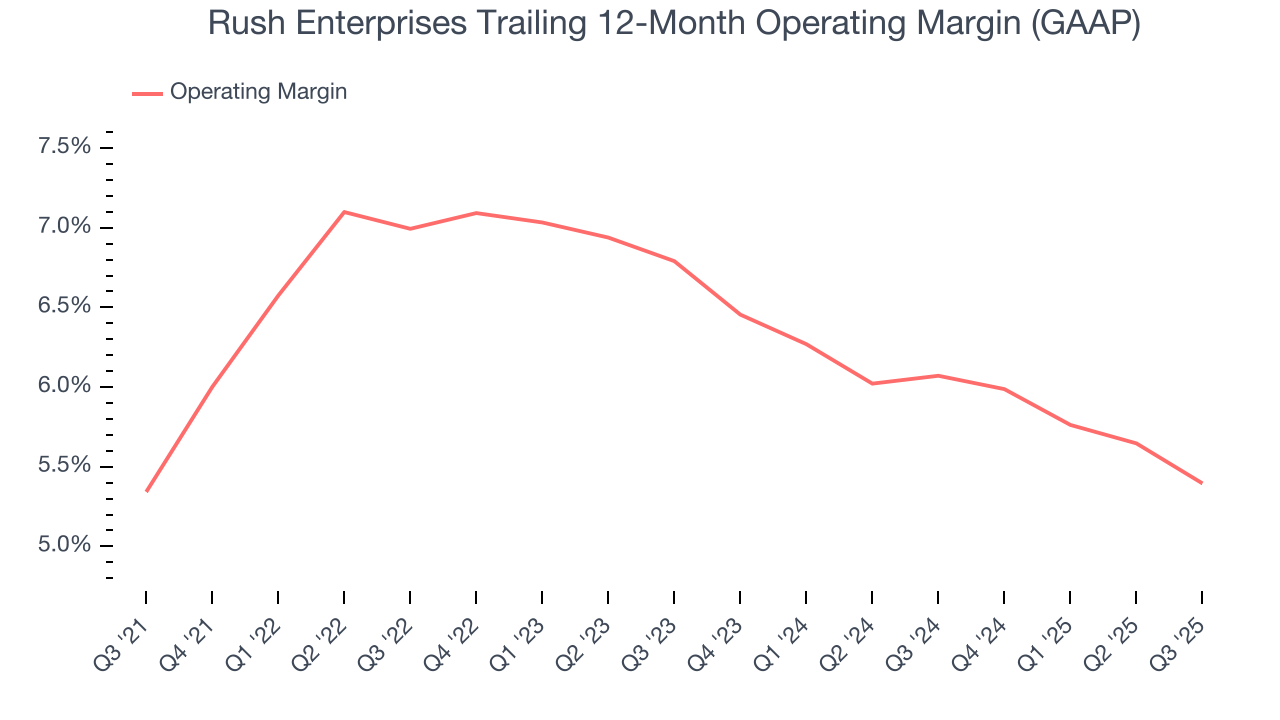
This quarter, Rush Enterprises generated an operating margin profit margin of 5.3%, down 1 percentage points year on year. Since Rush Enterprises’s operating margin decreased more than its gross margin, we can assume it was less efficient because expenses such as marketing, R&D, and administrative overhead increased.
8. Earnings Per Share
We track the long-term change in earnings per share (EPS) for the same reason as long-term revenue growth. Compared to revenue, however, EPS highlights whether a company’s growth is profitable.
Rush Enterprises’s EPS grew at an astounding 23.7% compounded annual growth rate over the last five years, higher than its 9.9% annualized revenue growth. This tells us the company became more profitable on a per-share basis as it expanded.
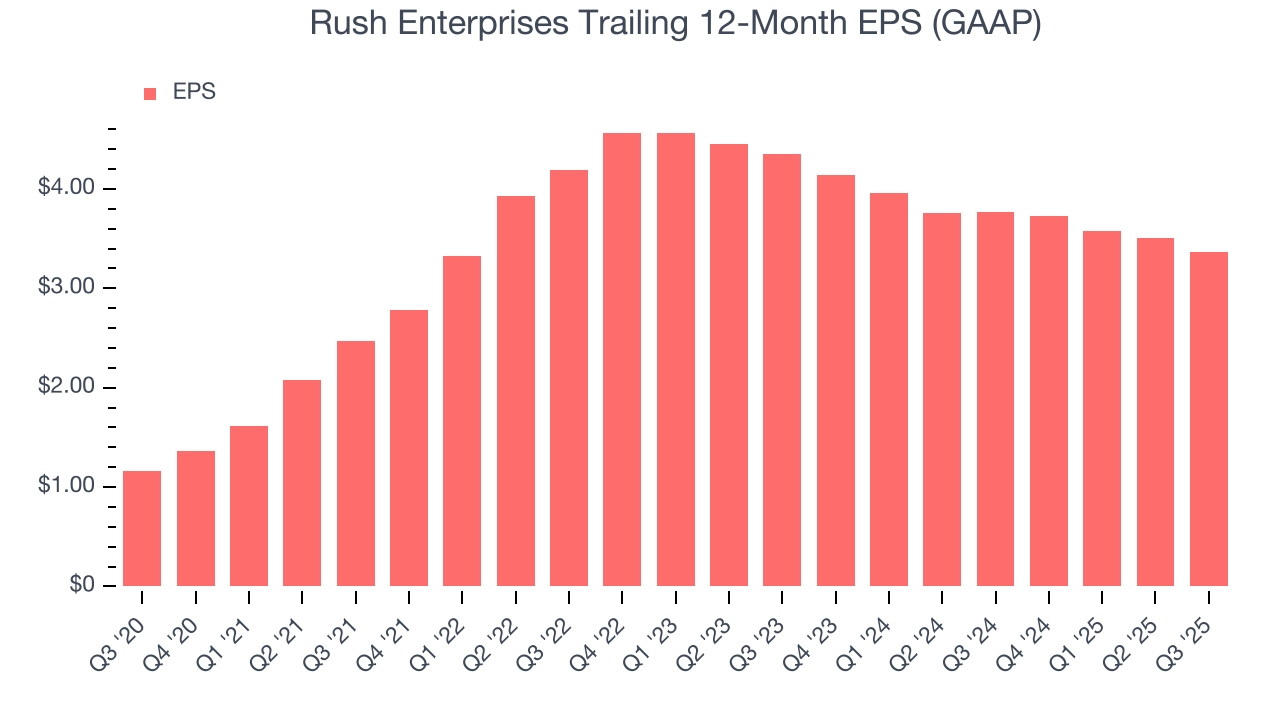
Diving into the nuances of Rush Enterprises’s earnings can give us a better understanding of its performance. A five-year view shows that Rush Enterprises has repurchased its stock, shrinking its share count by 4.8%. This tells us its EPS outperformed its revenue not because of increased operational efficiency but financial engineering, as buybacks boost per share earnings. 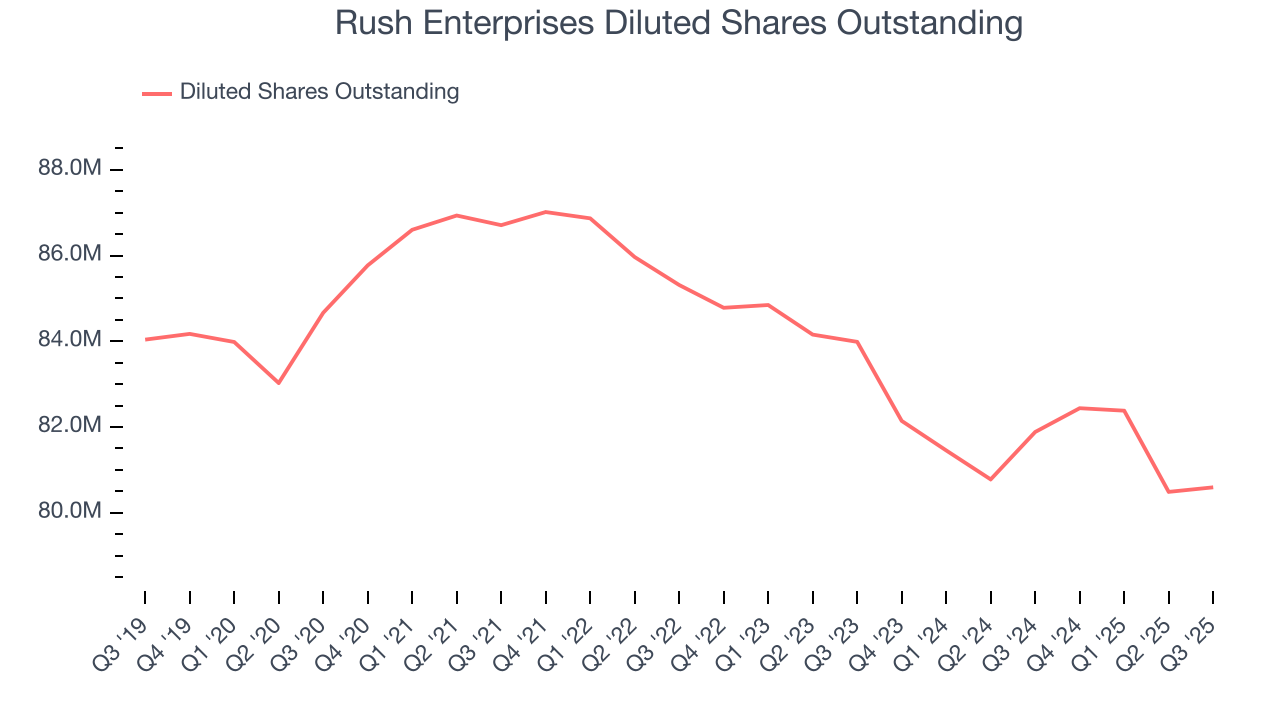
Like with revenue, we analyze EPS over a shorter period to see if we are missing a change in the business.
For Rush Enterprises, its two-year annual EPS declines of 12% mark a reversal from its (seemingly) healthy five-year trend. We hope Rush Enterprises can return to earnings growth in the future.
In Q3, Rush Enterprises reported EPS of $0.83, down from $0.97 in the same quarter last year. Despite falling year on year, this print beat analysts’ estimates by 1.8%. Over the next 12 months, Wall Street expects Rush Enterprises’s full-year EPS of $3.37 to grow 1.2%.
9. Cash Is King
If you’ve followed StockStory for a while, you know we emphasize free cash flow. Why, you ask? We believe that in the end, cash is king, and you can’t use accounting profits to pay the bills.
Rush Enterprises has shown poor cash profitability over the last five years, giving the company limited opportunities to return capital to shareholders. Its free cash flow margin averaged 2.2%, lousy for an industrials business.
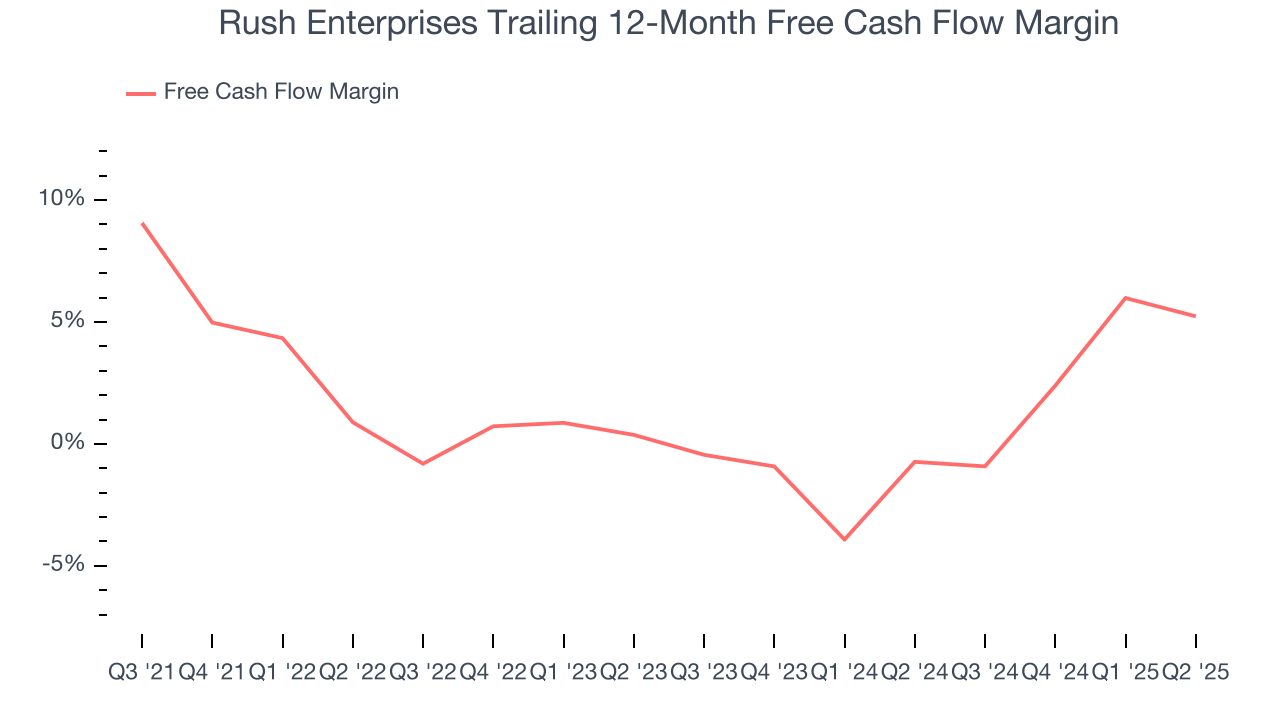
10. Return on Invested Capital (ROIC)
EPS and free cash flow tell us whether a company was profitable while growing its revenue. But was it capital-efficient? A company’s ROIC explains this by showing how much operating profit it makes compared to the money it has raised (debt and equity).
Rush Enterprises’s management team makes decent investment decisions and generates value for shareholders. Its five-year average ROIC was 11.9%, slightly better than typical industrials business.
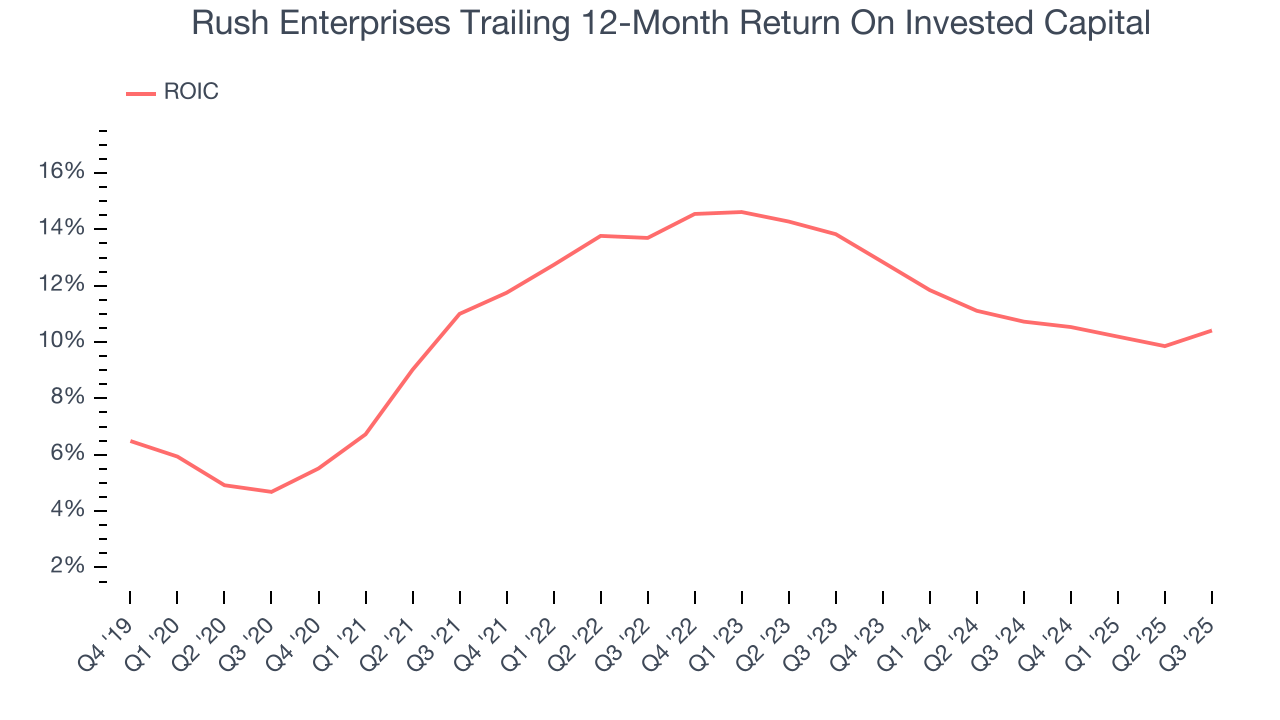
We like to invest in businesses with high returns, but the trend in a company’s ROIC is what often surprises the market and moves the stock price. Unfortunately, Rush Enterprises’s ROIC averaged 1.8 percentage point decreases over the last few years. We like what management has done in the past, but its declining returns are perhaps a symptom of fewer profitable growth opportunities.
11. Balance Sheet Assessment
Rush Enterprises reported $242 million of cash and $515.2 million of debt on its balance sheet in the most recent quarter. As investors in high-quality companies, we primarily focus on two things: 1) that a company’s debt level isn’t too high and 2) that its interest payments are not excessively burdening the business.
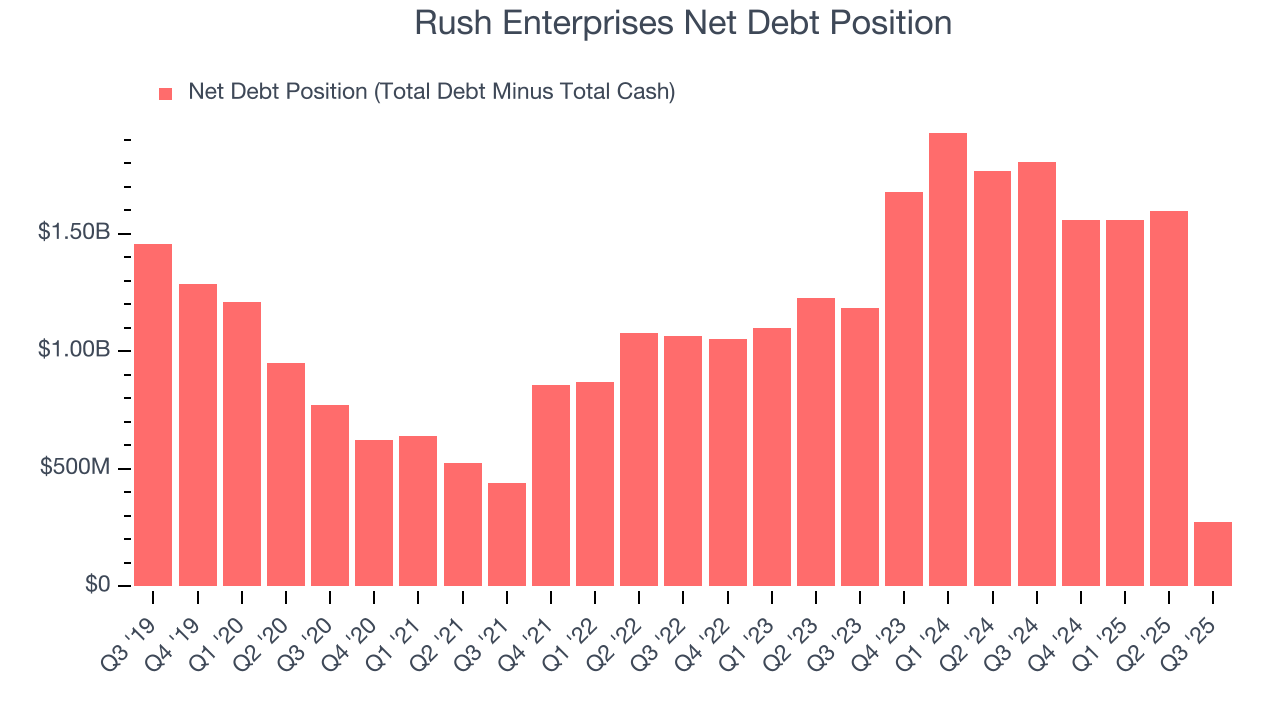
With $1.02 billion of EBITDA over the last 12 months, we view Rush Enterprises’s 0.3× net-debt-to-EBITDA ratio as safe. We also see its $29.63 million of annual interest expenses as appropriate. The company’s profits give it plenty of breathing room, allowing it to continue investing in growth initiatives.
12. Key Takeaways from Rush Enterprises’s Q3 Results
We were impressed by how significantly Rush Enterprises blew past analysts’ revenue expectations this quarter. EPS also beat. Zooming out, we think this was a fine quarter. The stock remained flat at $50.38 immediately after reporting.
13. Is Now The Time To Buy Rush Enterprises?
Updated: December 4, 2025 at 9:04 PM EST
Before investing in or passing on Rush Enterprises, we urge you to understand the company’s business quality (or lack thereof), valuation, and the latest quarterly results - in that order.
We cheer for all companies making their customers lives easier, but in the case of Rush Enterprises, we’ll be cheering from the sidelines. Although its revenue growth was solid over the last five years, it’s expected to deteriorate over the next 12 months and its projected EPS for the next year is lacking. And while the company’s astounding EPS growth over the last five years shows its profits are trickling down to shareholders, the downside is its low gross margins indicate some combination of competitive pressures and high production costs.
Rush Enterprises’s P/E ratio based on the next 12 months is 16.8x. This valuation multiple is fair, but we don’t have much confidence in the company. There are more exciting stocks to buy at the moment.
Wall Street analysts have a consensus one-year price target of $57.50 on the company (compared to the current share price of $54.63).









